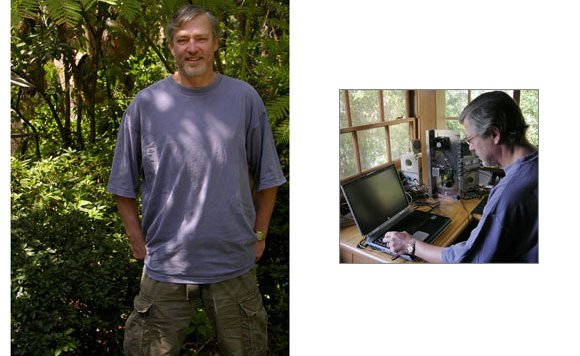
I was stunned last week to learn of the death of Keith Barr, the founder of Alesis and a beloved, legendary engineer of music technology. He was 61. An analog engineer gone digital, he led the charge to make digital reverb and studio recording affordable, and even after his Alesis years continued to be one of music’s great engineering minds.
Our condolences to Barr’s surviving family and to the countless friends and colleagues in the music industry and beyond.
Our friend James Grahame, Retro Thing founder and himself an engineer (via Reflex Audio and others, shares his memory of Keith with us:
Keith Barr was a musician’s engineer – his chip designs were all about sounding good rather than padding out spec sheets. A case in point is the Spin Semiconductor FV-1 reverb IC he designed in 2006. It uses a cheap 32.768 kHz crystal that you’d usually see in a real time clock circuit., generating an ADC/ DAC bandwidth of only 15 kHz. He commented that you could run the device from a 48 kHz clock, but you’d simply chew through delay memory faster without dramatically increasing the quality of the audio.
He also gave back to the engineering community by writing ASIC Design in the Silicon Sandbox: A Complete Guide to Building Mixed-Signal Integrated Circuits, in which he core dumps everything he’s learned about mixed signal chip design (including a business tips). The Spin FV-1 was designed at the same time he was writing his book, and it brings many of the ideas he writes about to life in stereo. In fact, the Spin Semi site is filled with stuff that’s usually kept inside R&D departments. The chip is extremely well documented with all kinds of useful design philosophies, code snippets and ideas hidden away in the knowledge base. I was stunned by his willingness to share his secrets, and by his almost childlike glee when someone did something unexpected with them.
A brief timeline:
- 1949: Keith Barr is born; spends teen years working with electronics and science
- 1973: Barr co-founds MXR Innovations, maker of a renowned line of pedals (hello, Van Halen)
- 1984: Barr founds Alesis Electronics in Hollywood. Barr focuses on engineering.
- 1985: The XT Reverb, created by Barr, is Alesis’ first product, and a landmark in making digital reverb accessible for the first time at US$799. It’s closely followed by the MIDIverb.
- 1987: Alesis makes a name for itself in sequencers (MMT8) and drum machines (HR-16), teaming up with Marcus Ryle (later founder of Line 6).
- 1987-1991: Barr conceptualizes a compact pro studio recorder, powered by digital tech. The result, released in 1991 as the ADAT, transforms the world of digital recording. (George Petersen for MIX points out this takes the price from Sony’s offering at $150,000 to the ADAT at $3995.)
- 2000: Barr is behind the Andromeda analog synth, arguably the instrument that helps launch a resurgent interest in new analog synths. He also uses his brilliant use of economy to produce cheap, fun instruments with gestural control, starting with the AirFX and 2001’s AirSynth.
- 2001: The victim of a changing business (and waning demand for ADAT), Alesis files for bankruptcy and is acquired by Jack O’Donnell, resulting in its reorganization as part of Numark. Barr leaves Alesis.
- 2002-2010: Barr goes on to innovate in integrated digital chip design, as founder and President of Spin Semiconductor. He continues to create ground-breaking designs, shares free DSP code, and literally writes the book on ASIC design for sound. Spin carries on this legacy of affordability with ASICs combining extensive processing features in single, affordable boards..
Barr remained focused on the future up to his death last week; while he cut his teeth on tube circuits, he had recently led the industry in exploiting ASICs for musical purposes. (ASIC stands for “Application-specific integrated circuit”; by building circuits specific to a purpose, they’re inexpensive, efficient circuitry tailored to a specific purpose, like audio processing.)
Spin’s own description of Barr sums up his vision:
Although an analog engineer at heart, he designs computer architectures, the most recent of which is the FV-1 processor (Spin’s first product). Keith sees ASIC design as the next step in electronics engineering, and designs all of his circuits from the bottom up, from the transistor level.
I hope that Barr’s designs will continue to have a future in production, and that we can bring more news soon.
Obituaries and more information:
Keith Barr – Alesis founder – In Memoriam: Pioneering inventor of Alesis ADAT, MIDIverb and MXR effects passes away [Sound on Sound]
RIP Keith Barr – Founder of Alesis and MXR [Matrixsynth, who also recalls the making of the Andromeda A6]
An extended obituary and history of Keith’s life by George Petersen:
In Memoriam: Keith Barr 1949-2010 [Mix]
Barr’s book:
ASIC Design in the Silicon Sandbox [McGrawHill] / Amazon link
Updated: Sean Costello adds, via comments:
I put up my own memorial post about Keith Barr on my blog:
http://valhalladsp.wordpress.com/2010/08/25/rip-keith-barr/
I shared Keith’s story about how he created the original MIDIverb, and how his intention was to create the world’s cheapest digital reverb, rather than competing with Lexicon et al. His later reverb designs were quite excellent, and he shared a great deal on the Spin Semiconductor website and via email.
Keith seemed like a really nice guy, and was clearly enthusiastic about his subject, even after several decades of being in the thick of it.
Thanks, Sean.